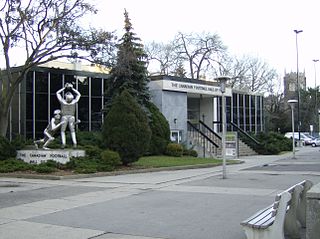Related Research Articles

The Canadian Football Hall of Fame (CFHOF) is a not-for-profit corporation, located in Hamilton, Ontario, that celebrates great achievements in Canadian football. It is maintained by the Canadian Football League (CFL). It includes displays about the CFL, Canadian university football and Canadian junior football history.
The 2002 CFL season is considered to be the 49th season in modern-day Canadian football, although it is officially the 45th Canadian Football League season.
The 2000 CFL season is considered to be the 47th season in modern-day Canadian football, although it is officially the 43rd Canadian Football League season.
The 1998 CFL season is considered to be the 45th season in modern-day Canadian football, although it is officially the 41st Canadian Football League season.
For the first time in Grey Cup history, the same two teams challenged for the trophy for the third consecutive year. But unlike the previous two years, the Toronto Argonauts needed some late game heroics to win their third consecutive title.
The Calgary Stampeders had an opportunity to defend their Grey Cup title in 1949, but the Montreal Alouettes returned the trophy to Quebec for just the third time in its history.
After a 17-year absence, the Saskatchewan Roughriders returned to the Grey Cup final. Their losing streak in the big game continued, however, as it was the other Rough Riders that took home the prize.
The Toronto Argonauts faced the Edmonton Eskimos in the Grey Cup. Although the Argos would hold on to win the game and their 10th Grey Cup championship, an Argo would not sip from the silver mug again until 1983.
The Hamilton Tiger-Cats defeated the Winnipeg Blue Bombers in the annual Grey Cup in 1953.
The Edmonton Eskimos upset the Montreal Alouettes to send the Grey Cup trophy back west for the first time since 1948.
The Edmonton Eskimos defeat the Montreal Alouettes in the first Grey Cup held in the west. This was also the first year that the Grey Cup was open to professional teams only, as the amateur Ontario Rugby Football Union was not invited to compete in an inter-union playdown, leaving only the Eastern Canadian Interprovincial Rugby Football Union and the Western Canadian Western Interprovincial Football Union to compete for the Canadian championship.
The Edmonton Eskimos faced the Montreal Alouettes in the Grey Cup game for the third consecutive year. And for the third consecutive year, the Edmonton Eskimos were Grey Cup champions. It was the first time in a Grey Cup that a touchdown was worth six points instead of five.
The Hamilton Tiger-Cats defeat the Winnipeg Blue Bombers in the Grey Cup.
The 1958 CFL season was the inaugural season of the Canadian Football League, although the season structure was essentially identical to that of the previous season conducted under the Canadian Football Council. The Hamilton Tiger-Cats and Winnipeg Blue Bombers met again for Canadian football supremacy. The Blue Bombers turned the tables on the Tiger-Cats this time, winning their first Grey Cup since 1941.
The 1959 CFL season was the sixth season in modern-day Canadian football, although officially it was the second season of the Canadian Football League. The Winnipeg Blue Bombers played the Hamilton Tiger-Cats for the third straight time in the Grey Cup final. The Blue Bombers won the rubber match in a defensive showdown.
The 1973 CFL Draft composed of nine rounds where 93 Canadian football players were chosen from eligible Canadian universities and, for the first time, Canadian players playing in the NCAA. Prior to 1973, teams were given exclusive signing privileges to Canadian players who attended U.S. schools based on the territory he was domiciled. After the draft was expanded to include NCAA schools, teams were also permitted to exempt from the draft and select players from their area, regardless of where they attended school.
The 1974 CFL Draft composed of nine rounds where 97 Canadian football players were chosen from eligible Canadian universities and Canadian players playing in the NCAA. A total of 18 players were selected as territorial exemptions. Through trades with the Winnipeg Blue Bombers, the Toronto Argonauts selected first in the first, second, and sixth rounds.
The 1980 CFL Draft composed of seven rounds where 80 Canadian football players were chosen from eligible Canadian universities and Canadian players playing in the NCAA. A total of 18 players were selected as territorial exemptions, with all nine teams making at least one selection in this stage of the draft.
References
- ↑ "60 years later: 1950 Mud Bowl". CFL.ca. 2010-11-25. Retrieved 2019-10-06.